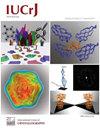过冷原子液体中无序晶体形成的飞秒x射线互相关分析。
IF 3.6
2区 材料科学
Q2 CHEMISTRY, MULTIDISCIPLINARY
引用次数: 0
摘要
我们展示了一种先进的散射方法,利用飞秒x射线衍射和x射线相互关联分析的组合来获取在快速过冷的稀有气体液体中形成的晶体结构的三维倒易空间。从散射信号中保留角度信息,可以沿倒易空间的选定方向探测结构因子,并识别在方位角积分散射曲线中无法检测到的特征。因此,尽管每个探针的晶体取向和形态存在固有的变化,但可以从随机结晶过程的连续衍射实验中获得更多的信息。我们还展示了相关图中的不同特征如何与某些形式的层错相关联,这使得原位研究这些缺陷并从晶体尺寸和温度的同时变化中分离出来。本文章由计算机程序翻译,如有差异,请以英文原文为准。
Femtosecond X-ray cross-correlation analysis of disordered crystals forming in a supercooled atomic liquid
We demonstrate an advanced scattering method for accessing the 3D reciprocal space of crystalline structures forming in a rapidly supercooled noble-gas liquid using a combination of femtosecond X-ray diffraction and X-ray cross-correlation analysis.
We demonstrate an advanced scattering method for accessing the 3D reciprocal space of crystalline structures forming in a rapidly supercooled noble-gas liquid using a combination of femtosecond X-ray diffraction and X-ray cross-correlation analysis. The preservation of angular information from the scattering signal allows probing the structure factor along selected directions in reciprocal space and identifying signatures undetectable in azimuthally integrated scattering curves. Therefore, more information from serial diffraction experiments on stochastic crystallization processes can be retrieved despite the inherent variation of the crystal orientation and morphology for each single probe. We also demonstrate how different features in the correlation maps can be associated with certain forms of stacking faults, which enables studying such defects in situ and disentangling them from simultaneous changes in crystal size and temperature.
求助全文
通过发布文献求助,成功后即可免费获取论文全文。
去求助
来源期刊

IUCrJ
CHEMISTRY, MULTIDISCIPLINARYCRYSTALLOGRAPH-CRYSTALLOGRAPHY
CiteScore
7.50
自引率
5.10%
发文量
95
审稿时长
10 weeks
期刊介绍:
IUCrJ is a new fully open-access peer-reviewed journal from the International Union of Crystallography (IUCr).
The journal will publish high-profile articles on all aspects of the sciences and technologies supported by the IUCr via its commissions, including emerging fields where structural results underpin the science reported in the article. Our aim is to make IUCrJ the natural home for high-quality structural science results. Chemists, biologists, physicists and material scientists will be actively encouraged to report their structural studies in IUCrJ.
 求助内容:
求助内容: 应助结果提醒方式:
应助结果提醒方式:


